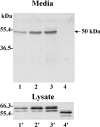Cleavage at the stem region releases an active ectodomain of the membrane type 1 matrix metalloproteinase
- PMID: 15560752
- PMCID: PMC1134979
- DOI: 10.1042/BJ20041324
Cleavage at the stem region releases an active ectodomain of the membrane type 1 matrix metalloproteinase
Abstract
MT1-MMP (membrane type 1 matrix metalloproteinase) is a membrane-anchored MMP that can be shed to the extracellular milieu. In the present study we report the primary structure and activity of the major soluble form of MT1-MMP. MS analysis of the purified 50-kDa soluble MT1-MMP form shows that the enzyme extends from Tyr112 to Val524, indicating that formation of this species requires a proteolytic cleavage within the stem region. In agreement, deletion of the entire stem region of MT1-MMP inhibited shedding of the 50-kDa species. A recombinant 50-kDa species (Tyr112-Val524) expressed in cells exhibited enzymatic activity against pro-MMP-2 and galectin-3, and thus this species is a competent protease. The recombinant 50-kDa soluble form also decreased the level of surface-associated TIMP-2 (tissue inhibitor of metalloproteinase 2) when administered to cells expressing wild-type membrane-anchored MT1-MMP, suggesting that ectodomain shedding of MT1-MMP can alter the MMP/TIMP balance on the cell surface. A approximately 53-kDa species of MT1-MMP was also isolated from a non-detergent extract of human breast carcinoma tissue and was found to lack the cytosolic tail, as determined with specific MT1-MMP domain antibodies. Together, these data show that MT1-MMP ectodomain shedding is a physiological process that may broaden MT1-MMP activity to the pericellular space.
Figures







Similar articles
-
Complex pattern of membrane type 1 matrix metalloproteinase shedding. Regulation by autocatalytic cells surface inactivation of active enzyme.J Biol Chem. 2002 Jul 19;277(29):26340-50. doi: 10.1074/jbc.M200655200. Epub 2002 May 9. J Biol Chem. 2002. PMID: 12004057
-
Domain interactions in the gelatinase A.TIMP-2.MT1-MMP activation complex. The ectodomain of the 44-kDa form of membrane type-1 matrix metalloproteinase does not modulate gelatinase A activation.J Biol Chem. 2000 Dec 15;275(50):39497-506. doi: 10.1074/jbc.M005932200. J Biol Chem. 2000. PMID: 10991943
-
TIMP-2 (tissue inhibitor of metalloproteinase-2) regulates MMP-2 (matrix metalloproteinase-2) activity in the extracellular environment after pro-MMP-2 activation by MT1 (membrane type 1)-MMP.Biochem J. 2003 Sep 15;374(Pt 3):739-45. doi: 10.1042/BJ20030557. Biochem J. 2003. PMID: 12755684 Free PMC article.
-
Membrane type-1 matrix metalloproteinase and TIMP-2 in tumor angiogenesis.Matrix Biol. 2003 Mar;22(1):55-61. doi: 10.1016/s0945-053x(03)00003-9. Matrix Biol. 2003. PMID: 12714042 Review.
-
The Role of Membrane-Type 1 Matrix Metalloproteinase-Substrate Interactions in Pathogenesis.Int J Mol Sci. 2023 Jan 22;24(3):2183. doi: 10.3390/ijms24032183. Int J Mol Sci. 2023. PMID: 36768503 Free PMC article. Review.
Cited by
-
Matrix metalloproteinases, synaptic injury, and multiple sclerosis.Front Psychiatry. 2010 Oct 5;1:130. doi: 10.3389/fpsyt.2010.00130. eCollection 2010. Front Psychiatry. 2010. PMID: 21423441 Free PMC article.
-
Intercellular transfer of cancer cell invasiveness via endosome-mediated protease shedding.Nat Commun. 2024 Feb 10;15(1):1277. doi: 10.1038/s41467-024-45558-8. Nat Commun. 2024. PMID: 38341434 Free PMC article.
-
Pharmacoproteomics of a metalloproteinase hydroxamate inhibitor in breast cancer cells: dynamics of membrane type 1 matrix metalloproteinase-mediated membrane protein shedding.Mol Cell Biol. 2008 Aug;28(15):4896-914. doi: 10.1128/MCB.01775-07. Epub 2008 May 27. Mol Cell Biol. 2008. PMID: 18505826 Free PMC article.
-
Proteolytic regulation of a galectin-3/Lrp1 axis controls osteoclast-mediated bone resorption.J Cell Biol. 2023 Apr 3;222(4):e202206121. doi: 10.1083/jcb.202206121. Epub 2023 Mar 2. J Cell Biol. 2023. PMID: 36880731 Free PMC article.
-
Matrilysin-1 (MMP7) cleaves galectin-3 and inhibits wound healing in intestinal epithelial cells.Inflamm Bowel Dis. 2011 Jan;17(1):260-7. doi: 10.1002/ibd.21443. Epub 2010 Sep 1. Inflamm Bowel Dis. 2011. PMID: 20812334 Free PMC article.
References
-
- Hotary K. B., Allen E. D., Brooks P. C., Datta N. S., Long M. W., Weiss S. J. Membrane type I matrix metalloproteinase usurps tumor growth control imposed by the three-dimensional extracellular matrix. Cell. 2003;114:33–45. - PubMed
-
- Ohuchi E., Imai K., Fujii Y., Sato H., Seiki M., Okada Y. Membrane type 1 matrix metalloproteinase digests interstitial collagens and other extracellular matrix macromolecules. J. Biol. Chem. 1997;272:2446–2451. - PubMed
-
- Strongin A. Y., Collier I., Bannikov G., Marmer B. L., Grant G. A., Goldberg G. I. Mechanism of cell surface activation of 72-kDa type IV collagenase. Isolation of the activated form of the membrane metalloprotease. J. Biol. Chem. 1995;270:5331–5338. - PubMed
-
- Knauper V., Will H., Lopez-Otin C., Smith B., Atkinson S. J., Stanton H., Hembry R. M., Murphy G. Cellular mechanisms for human procollagenase-3 (MMP-13) activation. Evidence that MT1-MMP (MMP-14) and gelatinase a (MMP-2) are able to generate active enzyme. J. Biol. Chem. 1996;271:17124–17131. - PubMed
Publication types
MeSH terms
Substances
Grants and funding
LinkOut - more resources
Full Text Sources
Other Literature Sources
Research Materials
Miscellaneous

